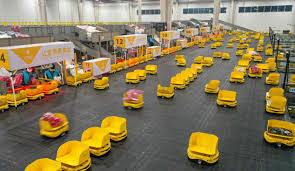China’s courier sector handled a total of 108.3 billion parcels last year, which represented a surge of 29.9 percent from a year earlier and accounted for over half of the parcels handled across the world, according to the State Post Bureau (SPB).
Many of these 108.3 billion parcels made arduous journeys to remote areas of China and even foreign countries.
Thanks to the hard work of couriers, packages from north China’s Beijing, east China’s Shanghai and south China’s Guangdong province can arrive in Zhaxizom township, Tingri county, southwest China’s Tibet autonomous region, which is located at an altitude of over 4,000 meters at the foot of Mount Qomolangma, within five days.
Meanwhile, parcels sent from Shenzhen, Guangdong province, can fly across the Pacific Ocean and arrive in Los Angeles the next day.
After four years of construction, Ezhou Huahu Airport in Ezhou city, central China’s Hubei province, recently completed calibration flights, which means that the first cargo airport in China is one more step closer toward official operation.
The airport is without doubt a major project in China’s courier sector in recent years. It represents the first time that Chinese courier companies have expanded investment to airports, a result of the fast development of the industry as well as consumers’ high requirements for delivery timeliness.
The airport’s 1.5-hour flight circle will cover 80 percent of China’s population. And flights departing from the airport can reach major airports in China within one night and those in foreign countries the next day.
The annual cargo and mail throughput of Ezhou Huahu Airport is expected to reach 3.3 million tonnes by 2030.
The fast expansion of the courier sector has provided opportunities for the rapid development of the logistics equipment industry.
As express delivery business volume continues to grow, parcels can’t possibly all be sorted through manual work. The industry is in urgent need of a boost from technologies.
Wayz Intelligent Manufacturing Technology Co., Ltd., a high-tech enterprise engaging in the in-depth research on core technologies of the logistics industry, was listed on the sci-tech innovation board of the Shanghai Stock Exchange on Oct. 26, 2021, the same year when it celebrated the 5th anniversary of its founding.
By then, the company had delivered 300 sets of cross-belt sortation system. As of the end of 2021, its products had been exported to many countries and regions. The company plans to continuously strengthen the construction of overseas market channels and expand its business to more markets.
Multinational pharmaceutical company AstraZeneca’s supply base in Wuxi city, east China’s Jiangsu province, has significantly improved efficiency in sending off goods by connecting its order system to SF DHL Supply Chain, a leading supply chain service provider in China.
After entrusting the comprehensive management of its high-bay warehouses to SF DHL Supply Chain, the supply base can now send off up to 20,000 to 30,000 boxes of products a day, compared with merely 2,000 to 3,000 in the past.
Chinese logistics company Suning Logistics has taken on after-sales services of manufacturing industry. Its employees not only deliver furniture consumers purchase online to their homes, but install the furniture for them.
The fact that more and more courier companies have started to establish cooperative relations with manufacturing enterprises shows that besides providing delivery services express delivery companies are also trying to embed facilities, systems and services in the production, sale and even after-sales links of manufacturing enterprises, becoming inseparable from the production and circulation process of manufacturing.
Cross-border courier services make it easier for consumers to purchase products from across the world and for companies to sell their products to various countries and regions.
In November 2021, the seven distribution centers of Cainiao Network, the logistics arm of Alibaba Group, in Belgium’s Liege, Spain’s Madrid, France’s Paris, Germany’s Bremen, Italy’s Rome, Hungary’s Budapest and Russia’s Moscow were officially put into operation.
Besides, Cainiao Network has also launched more than 300 charter flights, with an estimated cargo capacity of more than 30,000 tonnes.
In fact, many Chinese courier companies have accelerated the business expanding in overseas markets in recent years, building a total of 240 overseas warehouses with a total area of nearly 2 million square meters.
The vigorous development of the courier sector not only helps the manufacturing industry reduce costs and increase efficiency through integration with it, but also stimulates the overseas sales of domestic products, facilitates the cross-border flow of commodities, and brings more opportunities to the sector and other related industries.



